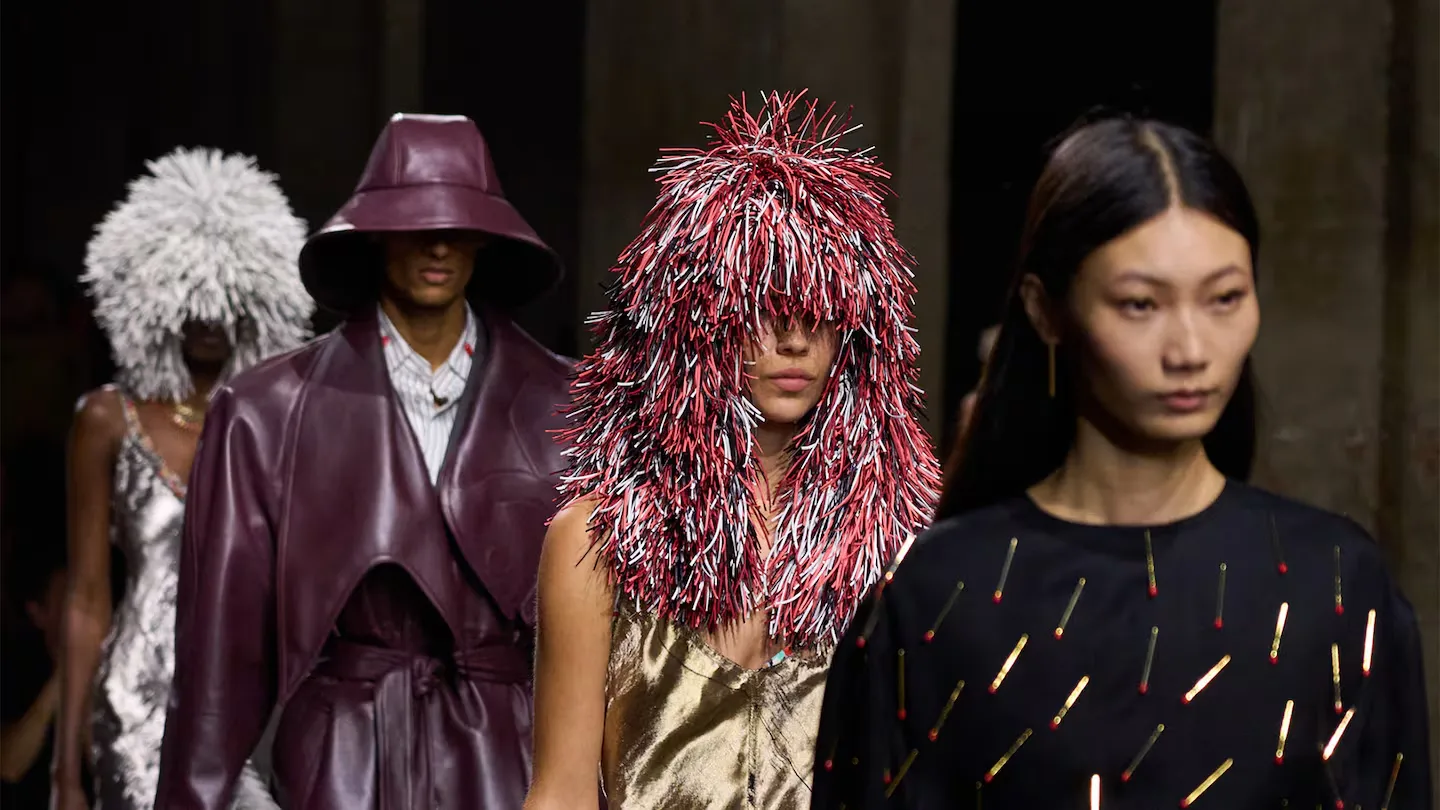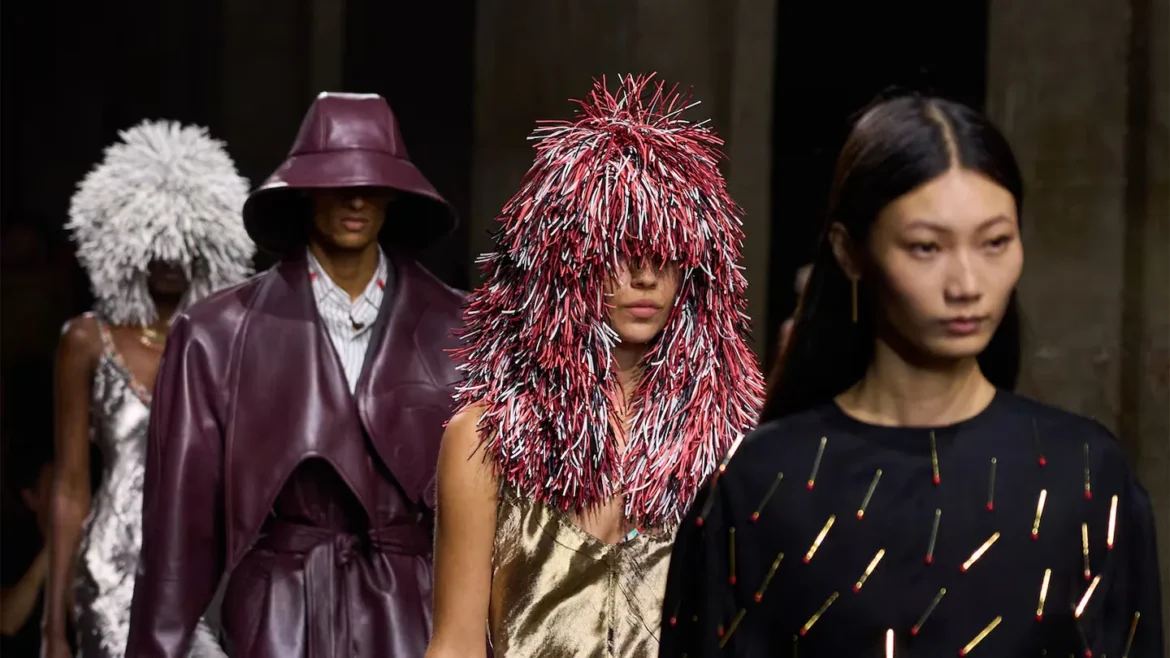Table of Contents
Tim Blanks and Imran Amed Reflect on the Spring/Summer 2025 Shows

Looking back on the most memorable moments of fashion month, the editor-in-chief and editor-at-large of BoF discussed the reactions of designers to a changing world.
Background
During the Spring/Summer 2025 shows, designers struggled to find a balance between restraint and expression. This led to collections that aimed to have a deeper emotional and intellectual effect, especially in light of the economic uncertainties, the global luxury sector downturn, and the escalating hostilities throughout the world.
As they prepare for the worst, megabrands have reduced the lavish celebrations around fashion week and are instead focussing on streamlining their shows and cutting costs.
A widespread apprehension and readjustment, in my opinion, are present. Tim Blanks, editor-at-large of The Business of Fashion, asserts that the current global situation encourages contemplation more than ostentation.
Those designers, however, stood out the most because they dared to be imaginative. In the midst of world conflict, Francesco Risso staged a cinematic extravaganza at Marni that elevated cotton from a simple material to one with expressive designs, highlighting the beauty of simplicity.
At Valentino, Alessandro Michele finally made his debut, paying homage to the house’s founder Valentino Garavani while adding his own unique style. Jonathan Anderson provoked a reevaluation of conventional beauty standards and an exploration of unconventional silhouettes at Loewe by manipulating scale and perspective.
Joining Tim Blanks and Imran Amed on this edition of The BoF Podcast, they break down the biggest moments from Fashion Month and talk about how the world’s current situation is impacting designers and brands.
Major Takeaways
Alessandro Michele’s much anticipated debut for Valentino was a masterclass in fusing the house’s legendary history with his own distinctive creative vision. Like couples reuniting after decades of separation and experiencing “that kind of explosion of joy,” Blanks likens the partnership to “a natural consummation.”
The recent Gucci projects by Sabato De Sarno illustrate the challenges of reimagining a house with such a storied history. Despite his best efforts, his collections have been panned for failing to live up to Gucci’s legendary reputation for daring and originality. The challenge, according to Blanks, is “making a fresh narrative for Gucci when the old narratives are just so dominating.”
Jonathan Anderson persisted in challenging convention at Loewe by playing around with perspective and scale. Anderson’s designs often featured voluminous hoop skirts that floated in midair, manipulating the viewer’s sense of movement and shape.
Anderson encourages contemplation “by presenting them with something that makes them wonder, how would I wear that?,” as Blanks notes, and “he likes to challenge people’s points of view.” I don’t know how to sit in that.
Featuring once-extreme proportions softened into more wearable silhouettes, the collection by up-and-coming designer Duran Lantink left quite an impression. Those garments embody the tangible expression of autonomous thought. “Fashion needs more of that—what we need is more independent thought,” Blanks argues.
“I think the future of the fashion industry is in good hands with some of these younger designers that haven’t necessarily had a big role in a house yet but certainly deserve an opportunity to show what they can do,” Amed says, echoing the significance of cultivating fresh talent. The industry needs to stop being so cautious, and I believe that’s a big part of it. Maintaining a safe environment is dull.
ٹِم بلینکس اور عمران احمد کی بہار/گرمی 2025 کے شوز پر نظرِ ثانی
فیشن کے مہینے کے سب سے یادگار لمحات کو سامنے رکھتے ہوئے، دی بزنس آف فیشن کے مدیرِ اعلیٰ اور مدیرِ وسیع نے اس بات پر گفتگو کی کہ بدلتی ہوئی دنیا کے اثرات پر ڈیزائنرز نے کیسے ردِعمل دیا۔
پس منظر
بہار/گرمی 2025 کے شوز کے دوران ڈیزائنرز کو ضبط اور اظہار کے درمیان توازن قائم کرنے میں خاصی جدوجہد نظر آئی۔ معاشی بے یقینی، عالمی سطح پر لگژری صنعت کی سست روی اور دنیا بھر میں بڑھتے ہوئے تنازعات کے باعث، مجموعوں میں جذباتی اور فکری گہرائی پیدا کرنے کی کوشش کی گئی۔
خراب حالات کے خدشے کے پیشِ نظر، بڑے برانڈز نے فیشن ویک کے اردگرد ہونے والی شاندار تقریبات کم کر دیں اور اس کے بجائے شوز کو سادہ بنانے اور اخراجات گھٹانے پر توجہ دی۔
ٹِم بلینکس کے مطابق، موجودہ عالمی حالات نمائش اور دکھاوے سے زیادہ غور و فکر کی ترغیب دے رہے ہیں۔ ان کے خیال میں فیشن کی فضا میں ایک عمومی بے چینی اور ازسرِنو ترتیب کا احساس موجود ہے۔
تاہم، وہ ڈیزائنرز سب سے نمایاں رہے جنہوں نے حالات کے باوجود تخلیقی جرات دکھائی۔ عالمی کشیدگی کے دوران، فرانسسکو ریسو نے مارنی میں ایک فلمی انداز کا شو پیش کیا جس میں سادہ کپاس کو اظہار کی علامت بنا کر سادگی کے حسن کو اجاگر کیا گیا۔
ویلنٹینو میں، الیساندرو میکیلے نے آخرکار اپنا پہلا مجموعہ پیش کیا، جس میں انہوں نے ادارے کے بانی ویلنٹینو گاروانی کو خراجِ تحسین پیش کرتے ہوئے اپنی منفرد پہچان بھی شامل کی۔ لووے میں، جوناتھن اینڈرسن نے پیمانے اور زاویے سے کھیلتے ہوئے روایتی حسن کے تصورات کو چیلنج کیا اور غیر معمولی ساختوں کو دریافت کیا۔
اس قسط میں ٹِم بلینکس اور عمران احمد نے فیشن کے مہینے کے بڑے لمحات پر بات کی اور یہ بھی واضح کیا کہ موجودہ عالمی حالات ڈیزائنرز اور برانڈز پر کس طرح اثر انداز ہو رہے ہیں۔
اہم نکات
الیساندرو میکیلے کا ویلنٹینو کے لیے طویل انتظار کے بعد پہلا مجموعہ ادارے کی تاریخی وراثت اور ان کے ذاتی تخلیقی وژن کا شاندار امتزاج ثابت ہوا۔ ٹِم بلینکس نے اس اشتراک کو اُن جوڑوں سے تشبیہ دی جو برسوں کی جدائی کے بعد ملتے ہیں اور خوشی کا ایک زبردست دھماکہ ہوتا ہے—ان کے نزدیک یہ ملاپ فطری اور مکمل تھا۔
گوچی میں سباتو دے سارنو کے حالیہ منصوبے ایک ایسے ادارے کو نئے سرے سے تصور کرنے کی مشکل کو ظاہر کرتے ہیں جس کی تاریخ بہت مضبوط ہو۔ ٹِم بلینکس کے مطابق، اصل چیلنج یہ ہے کہ جب پرانی کہانیاں اتنی غالب ہوں تو نئی داستان کیسے تخلیق کی جائے۔
لووے میں جوناتھن اینڈرسن نے زاویے اور پیمانے سے کھیل کر روایات کو چیلنج کرنا جاری رکھا۔ ان کے مجموعے میں بڑے، ہوا میں معلق نظر آنے والے گھیر دار اسکرٹس شامل تھے جو حرکت اور ساخت کے احساس کو بدل دیتے ہیں۔ بلینکس کے مطابق، اینڈرسن ناظرین کو سوچنے پر مجبور کرتے ہیں—یہ سوال پیدا ہوتا ہے کہ ایسا لباس کیسے پہنا جائے۔
ابھرتے ہوئے ڈیزائنر دوران لینٹنک کے مجموعے نے بھی گہرا اثر چھوڑا، جہاں کبھی انتہائی سمجھی جانے والی ساختوں کو پہننے کے قابل انداز میں پیش کیا گیا۔ یہ لباس آزاد سوچ کے عملی اظہار کی مثال تھے۔ ٹِم بلینکس کا کہنا ہے کہ فیشن کو مزید آزاد اور خودمختار خیالات کی ضرورت ہے۔
عمران احمد کے مطابق، فیشن کی صنعت کا مستقبل اُن نوجوان ڈیزائنرز کے ہاتھوں میں محفوظ ہے جنہیں ابھی بڑے اداروں میں بھرپور مواقع نہیں ملے، مگر وہ اپنی صلاحیت دکھانے کے حقدار ہیں۔ ان کا ماننا ہے کہ صنعت کو حد سے زیادہ محتاط ہونے کے بجائے جرات مندی اپنانی چاہیے، کیونکہ حد سے زیادہ محفوظ رہنا فیشن کو بے رنگ بنا دیتا ہے۔
